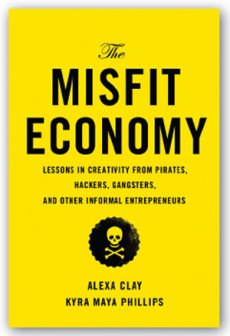Over the past decade, scholars and journalists have begun to study social movement activists, corporate reformers, and other unconventional innovators in order to improve our understanding of how change happens within institutions. In part, this trend reflects shifts in the world of organizational practice—the decline of traditional employment and the rise of the “gig economy,” the expansion of shareholder activism, the upending of incumbent industry leaders by insurgent start-ups, and so forth. In this context, the idea of examining institutional change from the vantage point of “outsider” figures has proven to be quite persuasive.
Yet this approach, despite its explanatory power, has its limits. The Misfit Economy, by Alexa Clay and Kyra Maya Phillips, illustrates both the insights that we can glean from studying outsiders and the problems that result when we transfer ideas and practices from one social space to another without paying suffi cient attention to contextual differences.
Clay is a cofounder of the League of Intrapreneurs, a group that supports change agents in business. Phillips, a former journalist, cofounded the Point People, a network of thinkers and entrepreneurs who pursue systemic social change. To develop this book, they conducted in-depth examinations of 30 cases in which outsiders—“misfits,” as the authors call them—were able to “pioneer an unusual, creative, or alternative way of working.” To qualify for inclusion in the book, the authors explain, an “innovation had to lead to some kind of disruption—to the transformation of an attitude, norm, or organizational practice.” The cases span various regions, time periods, and fields of activity. Some of them (computer hackers, antiviolence activists) are familiar and commonly associated with economic or social innovation. Others (Somali pirates, Chinese producers of knockoff merchandise) are familiar but counterintuitive. Still others (the Latin Kings street gang, a camel milk entrepreneur, and even a Harvard University professor turned alien-abduction believer) are obscure or have a dubious link to innovation as people conventionally understand it.
Clay and Phillips organize the book into three parts. They start by offering an explanation of what they mean by “misfits.” Then, in the core of the book, they provide a detailed look at five strategies that misfits tend to follow: hustling, copying, hacking, provoking, and pivoting. Finally, they explore lessons that we can take from outsiders about the practice of economic and social innovation.
Several merits of The Misfit Economy are worth noting. First, it offers useful insights into the way that innovation can occur on the fringes of established institutions. Clay and Phillips, for example, write thought-provokingly about “gray market” practices that lead to transformation within the legitimate economy. Second, the book delivers helpful lessons on how to generate change within an established organization or field. Of particular note here is the case of David Berdish, an executive at Ford Motor Company who has been working to improve his firm’s sustainability and human rights record. Third, the book holds insights for both economic entrepreneurs and social entrepreneurs. Indeed, its overall framing raises interesting questions about the boundary between the economic and social spheres.
Yet that framing also generates one of the book’s most critical flaws. Clay and Phillips make the implicit assumption that innovation strategies that emerge from the social sector will also apply to the business sector (and vice versa). That’s often true, and investigating such cross-sector approaches can be highly informative. But not all misfits are the same. Most problematically, the authors deploy W.E.B. Du Bois’s concept of “double consciousness”—the idea that African-Americans must view themselves “through the eyes of others” (as Du Bois put it)—as a principle that relates to all outsiders. In doing so, Clay and Phillips imply that misfit innovators experience marginality in a way that is analogous to racial discrimination. Throughout the book, moreover, the authors loosely compare the work of committed social activists to that of business entrepreneurs. (“Rosa Parks challenged norms around segregation by refusing to give up her seat on the bus. Coco Chanel pushed the boundaries of women’s fashion and never hesitated to speak her mind,” they write.) These examples illustrate the importance of attending carefully to divergent social and economic contexts.
Another limitation of the book concerns its bewildering range of cases. Those cases will grip readers’ attention, to be sure, but the downside of featuring so many different kinds of innovators is that they become misfits of a different sort: In many instances, it’s not clear how they fit into the authors’ overall vision. This diversity of examples will also make it hard for readers to draw conclusions about which innovation strategies are most effective. Compounding this problem is one that social scientists call “sampling on the dependent variable”: Clay and Phillips have little to say about cases in which outsider-driven efforts fail. Investigating such cases might have revealed telling differences between successful and unsuccessful entrepreneurs.
On the whole, The Misfit Economy makes for lively reading. Although it lacks a strong guiding vision and a sharp analytic approach, leaders and scholars will be able to apply their own conceptual frameworks productively to the cases that Clay and Phillips describe.


